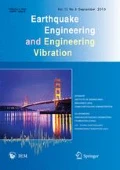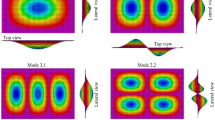Abstract
As a type of nonstructural component, infill walls play a significant role in the seismic behavior of high-rise buildings. However, the stiffness of the infill wall is generally either ignored or considered by simplified empirical criteria that lead to a period shortening. The difference can be greatly decreased by using a structural identification methodology. In this study, an ambient vibration test was performed on four on-site reinforced concrete high-rise buildings, and the design results were compared with the PKPM models using corresponding finite element (FE) models. A diagonal strut model was used to simulate the behavior of the infill wall, and the identified modal parameters measured from the on-site test were employed to calibrate the parameters of the diagonal strut in the FE models. The SAP2000 models with calibrated elastic modulus were used to evaluate the seismic response in the elastic state. Based on the load-displacement relationship of the infill wall, nonlinear dynamic analysis models were built in PERFORM-3D and calibrated using the measured modal periods. The analysis results revealed that the structural performance under small/large earthquake records were both strengthened by infill walls, and the contribution of infill walls should be considered for better accuracy in the design process.
Similar content being viewed by others
References
ASCE (2006), Minimum Design Loads for Buildings and Other Structures, Reston, VA.
ASCE (2011), Structural Identification of Constructed Systems: A State-of-the-art Report, ASCE-SEI Structural Identification of Constructed Systems Committee, Reston, VA.
Asteris PG, Antoniou ST, Sophianopoulos DS and Chrysostomou CZ (2011), “Mathematical Macromodeling of Infilled Frames: State of the Art,” Journal of Structural Engineering, 137(2): 1508–1517.
Asteris PG, Cotsovos DM, Chrysostomou CZ, Mohebkhah A and Al-Chaar GK (2013), “Mathematical Micromodeling of Infilled Frames: State of the Art,” Engineering Structures, 56(2): 1905–1921.
Ashok E, Dinesh SV and Dattatreya JK (2015), “Seismic Vulnerability Assessment and Comparison of RC Buildings with and without Infill Using Pushover Analysis,” Journal of Civil Engineering and Environment Technology, 2(2): 7–11.
Al-Nimry H, Resheidat M and Qeran S (2015), “Infilled RC Frame Buildings,” Earthquake Engineering and Engineering Vibration, 14(2): 275–293.
Almeida JP, Tarquini D and Beyer K (2016), “Modelling Approaches for Inelastic Behaviour of RC Walls: Multi-level Assessment and Dependability of Results,” Archives of Computational Methods in Engineering, 23(2): 69–100.
Abhijeet VC and Vaibhav VS (2017), “Pushover Analysis of High Rise Building and Outrigger System with or without In-filled Walls,” International Research Journal of Engineering and Technology, 4(2): 1439–1445.
Balendra T and Huang X (2003), “Overstrength and Ductility Factors for Steel Frames Designed According to BS 5950,” Journal of Structural Engineering, 129(2): 1019–1035.
Brownjohn JM (2003), “Ambient Vibration Studies for System Identification of Tall Buildings,” Earthquake Engineering & Structural Dynamics, 32(2): 71–95.
Brownjohn JMW and Pan TC (2008), “Identifying Loading and Response Mechanisms from Ten Years of Performance Monitoring of A Tall Building,” Journal of Performance of Constructed Facilities, 22(2): 24–34.
Burak B and Comlekoglu HG (2013), “Effect of Shear Wall Area to Floor Area Ratio on the Seismic Behavior of Reinforced Concrete Buildings,” Journal of Structural Engineering, 139(2): 1928–1937.
Carvalho EC and Coelho E (2001), “Seismic Assessment, Strengthening and Repair of Structures,” Ecoest2-Icons Report, 2: 3–9.
Catbas FN, Kijewski-Correa T and Aktan AE (2013), “Structural Identification of Constructed Systems: Approaches, Methods, and Technologies for Effective Practice of St-Id,” American Society of Civil Engineers (ASCE), Structural Engineering Institute (SEI).
Chaulagain H, Rodrigues H, Spacone E and Varum H (2016), “Seismic Safety Assessment of Existing Masonry Infill Structures in Nepal,” Earthquake Engineering and Engineering Vibration, 15(2): 251–268.
Dhakal RP, Pourali A, Tasligedik AS, Yeow T, Baird A, MacRae G, Pampanin S and Palermo A (2016), “Seismic Performance of Nonstructural Components and Contents in Buildings: an Overview of NZ Research,” Earthquake Engineering and Engineering Vibration, 15(2): 1–17.
Dolsek M and Fajfar P (2008), “The Effect of Masonry Infills on the Seismic Response of A Four Storey Reinforced Concrete Frame: A Probabilistic Assessment,” Engineering Structures, 30(2): 1991–2001.
Euro pean Committee for Standardization (2004), Design of structures for earthquake resistance, Eurocode 8, CEN, Brussels, Belgium.
Epackachi S, Mirghaderi R and Esmaili O (2012), “Seismic Evaluation of A 56-story Residential Reinforced Concrete High-rise Building Based on Nonlinear Dynamic Time History Analysis,” Structural Design of Tall & Special Buildings, 21(2): 233–248.
FEMA 274 (1997), NEHRP Commentary on the NEHRP Guidelines for the Seismic Rehabilitation of Buildings, Federal Emergency Management Agency, Washington.
Fardis MN and Panagiotakos TB (1997), “Seismic Design and Response of Bare and Masonry-infilled Reinforced Concrete Buildings, Part ii: Infilled Structures,” Journal of Earthquake Engineering, 1(2): 219–256.
FEMA 306 (1999), Evaluation of Earthquake Damaged Concrete and Masonry Wall Buildings: Basic Procedures Manual, Federal Emergency Management Agency, Washington.
Furtado A, Rodrigues H and Arede A (2015), “Modelling of Masonry Infill Walls Participation in the Seismic Behaviour of RC Buildings Using Opensees,” International Journal of Advanced Structural Engineering, 7(2): 117–127.
GB 50011-2010 (2010), Code for Seismic Design of Buildings, Beijing: China Architecture and Building Press.
Holmes M (1961), “Steel Frames with Brickwork and Concrete Infilling,” Proceedings of the Institution of Civil Engineers, 19(2): 473–478.
Henderson RC, Fricke KE, Jones WD, Beavers JE and Bennett RM (2003), “Summary of A Large- and Smallscale Unreinforced Masonry Infill Test Program,” Journal of Structural Engineering, 129(12):1667–1675.
Hashmi AK and Madan A (2008), “Damage Forecast for Masonry Infilled Reinforced Concrete Framed Buildings Subjected to Earthquakes in India,” Current Science, 94(2): 61–73.
Hans S, Boutin C, Ibraim E and Roussillon P (2010), “In Situ Experiments and Seismic Analysis of Existing Buildings. Part I: Experimental Investigations,” Earthquake Engineering & Structural Dynamics, 34(2): 1531–1546.
JGJ 3-2010 (2010), Technical Specification for Concrete Structures of Tall Building, Beijing: China Architecture and Building Press.
Kose MM and Karslioglu O (2010), “Effects of Infills on High-rise Buildings: A Case Study,” Structural Design of Tall & Special Buildings, 18(2): 907–920.
Kaushik HB, Rai DC and Jain SK (2012), “Code Approaches to Seismic Design of Masonry-Infilled Reinforced Concrete Frames: A State-of-the-Art Review,” Earthquake Spectra, 22(2): 961–983.
Liu SC and Yao JTP (1978), “Structural Identification Concept,” Journal of the Structural Division, 104(2): 1845–1858.
Li QS and Wu JR (2004), “Full-Scale Measurements and Numerical Evaluation of Wind-induced Vibration of A 63-story Reinforced Concrete Tall Building,” Engineering Structures, 26(2): 1779–1794.
Li QS, Wu JR, Liang SG, Xiao YQ and Wong CK (2004), “Correlation of Dynamic Characteristics of A Super-Tall Building from Full-Scale Measurements and Numerical Analysis with Various Finite Element Models,” Earthquake Engineering & Structural Dynamics, 33(2): 1311–1336.
Lu HS, Zhao FX (2007), “Site Coefficients Suitable to China Site Category,” Acta Seismologica Sinica, 29(2): 67–76.
Luis DD, Laura L and F abrizio M (2014), “Strength and Stiffness Reduction Factors for Infilled Frames with Openings,” Earthquake Engineering and Engineering Vibration, 13(2): 437–454.
Li QS, Zhi LH, Tuan YT, Kao CS and Su SC (2010), “Full-scale Measurements and Analysis of Wind-induced Response of Taipei-101 Tower,” Journal of Building Structures, 31(2): 24–31.
Mamun AA and Saatcioglu M (2017), “Seismic Performance Evaluation of Moderately Ductile RC Frame Structures Using Perform-3d,” 16th World Conference on Earthquake Engineering, Santiago Chile.
Mainstone RJ (1971), “Summary of Paper 7360, On the Stiffness and Strengths of Infilled Frames,” Ice Proceedings, 49(2): 230.
Manzouri T (1995), “Nonlinear Finite Element Analysis and Experimental Evaluation of Retrofitting Techniques for Unreinforced Masonry Structures,” University of Colorado-Boulder, USA.
Milheiro J, Rodrigues H and Arede Antonio (2016), “Evaluation of the Contribution of Masonry Infill Panels on the Seismic Behaviour of Two Existing Reinforced Concrete Buildings,” KSCE Journal of Civil Engineering, 20(2): 1365–1374.
Mwafy A, Elnashai A, Sigbjornsson R and Salama A (2006), “Significance of Severe Distant and Moderate Close Earthquakes on Design and Behavior of Tall Buildings,” Structural Design of Tall & Special Buildings, 15(2): 391–416.
Negro P and Colombo A (1997), “Irregularities Induced by Nonstructural Masonry Panels in Framed Buildings,” Engineering Structures, 19(2): 576–585.
NRCC (2005), National Building Code of Canada.
Nautiyal P, Singh S, Batham G and Publication I (2013), “A Comparative Study of the Effect of Infill Walls on Seismic Performance of Reinforced Concrete Buildings,” International Journal of Civil Engineering & Technology, 4(2): 208–218.
Nwofor TC and Chinwah JG (2014), “Finite Element Mode ling of Shear Strength of Infilled Frames with Openings,” International Journal of Engineering & Technology, 2(2): 992–1001.
Pacific Earthquake Engineering Research Center, http://ngawest2.berkeley.edu.
Paulay T and Priestley MJN (1992), Seismic Design of Reinforced Concrete and Masonry Buildings, Wiley.
Polyakov SV (1960), “On the Interaction between Masonry Filler Walls and Enclosing Frame when Loaded in the Plane of the Wall,” Translations in Earthquake Engineering, 2(2): 36–42.
Peeters B (2000), “System Identification and Damage Detection in Civil Engineering,” System Identification and Damage Detection in Civil Engineering, Katholieke University, Leuven, Belgium.
Smith BS (1962), “Lateral Stiffness of Infilled Frames,” Journal of the Structural Division, 88(2): 183–226.
Su RKL, Chandler AM, Sheikh MN and Lam NTK (2005), “Influence of Nonstructural Components on Lateral Stiffness of Tall Buildings,” Structural Design of Tall & Special Buildings, 14(2): 143–164.
Shing PB, Stavridis A, Koutromanos I, Willam K, Blackard B, Kyriakides MA and Arnold S (2009), “Seismic Performance of Non-Ductile RC Frames with Brick Infill,” ATC and SEI Conference on Improving the Seismic Performance of Existing Buildings and Other Structures, 1117–1128.
Sanada Y and Konishi D (2011), “Effects of Nonstructural Brick Infills on An Indonesian Earthquake-Damaged Building,” Procedia Engineering, 14: 2077–2085.
Su RKL and Lee CL (2013), “Development of Seismic Fragility Curves for Low-Rise Masonry Infilled Reinforced Concrete Buildings by a Coefficient-Based Method,” Earthquake Engineering and Engineering Vibration, 12(2): 319–332.
Tan DX, Zhou Y, Mi ST, Yi WJ, Xie LM and Jiang YZ (2015), “Ambient Vibration Dynamic Test and Finite Element Analysis for High-Rise Buildings,” China Civil Engineering Journal, 48(2): 40–50. (in Chinese)
Wu X (2012), “Model Transformation from NosaCAD to ABAQUS and PERFORM-3D and Nonlinear Structure Analysis by These Software,” Building Structure, 42(S2): 207–212. (in Chinese)
Wu XH, Sun FT, Lu XL and Qian J (2014), “Nonlinear Time History Analysis of China Pavilion for Expo 2010 Shanghai China,” Structural Design of Tall & Special Buildings, 23(2): 721–739.
Xu YL, Chen SW and Zhang RC (2003), “Modal Identification of Di Wang Building under Typhoon York Using the Hilbert-Huang Transform Method,” Structural Design of Tall & Special Buildings, 12(2): 21–47.
Zarnic R and Gostic S (1998), “Non-linear Modelling of Masonry Infilled Frames,” Proceedings of 11th European Conference on Earthquake Engineering, Paris.
Zhang CQ, Zhou Y, Zhou DY and Lu XL (2011), “Study on the Effect of the Infill Walls on the Seismic Performance of a Reinforced Concrete Frame,” Earthquake Engineering and Engineering Vibration, 10(2): 507–517.
Zhou Y, Zhou Y, Yi WJ, Tan DX and Mi ST (2017), “Operational Modal Analysis and Rational Finite-Element Model Selection for Ten High-Rise Buildings Based on On-Site Ambient Vibration Measurements,” Journal of Performance of Constructed Facilities, 31(5): 04017043.
Acknowledgement
The authors sincerely appreciate the funding support provided to this research by the National Key Research and Development Program of China (No. 2016YFC0701400, 2016YFC0701308), the Key Research and Development Program of Hunan Province (No. 2017SK2220), and the National Natural Science Foundation of China (NSFC) (No. 51878264).
Author information
Authors and Affiliations
Corresponding author
Additional information
Supported by: National Key Research and Development Program of China under Grant Nos. 2016YFC0701400 and 2016YFC0701308, the Key Research and Development Program of Hunan Province under Grant No. 2017SK2220, and the National Natural Science Foundation of China (NSFC) under Grant No. 51878264
Rights and permissions
About this article
Cite this article
Zhou, Y., Pei, Y., Zhou, Y. et al. Field measurements for calibration of simplified models of the stiffening effect of infill masonry walls in high-rise RC framed and shear-wall buildings. Earthq. Eng. Eng. Vib. 19, 87–104 (2020). https://doi.org/10.1007/s11803-020-0549-y
Received:
Accepted:
Published:
Issue Date:
DOI: https://doi.org/10.1007/s11803-020-0549-y




